![]()
![]()
![]()
Use LEFT and RIGHT arrow keys to navigate between flashcards;
Use UP and DOWN arrow keys to flip the card;
H to show hint;
A reads text to speech;
288 Cards in this Set
- Front
- Back
|
• Platyhelminthes
• Annelida • Nemertea (Paranemertes - ribbon worm) • Bryozoa (Bugula californica - moss animals) • Mollusca |
What Phyla exist within Superphylum Lophotrochozoa?
|
|
|
• Nematoda (Ascaris - parasitic)
• Onychophora (Peripatus - velvet worm) • Arthropoda |
What Phyla exist within Superphylum Ecdysozoa?
|
|
|
• Echinodermata
• Chordata |
What Phyla exist within Superphylum Deuterostomia?
|
|
|
• Calcarea
• Demonspongiae (Halichondria, Suberites) • Hexactinellida |
What Classes exist within Phylum Porifera?
|
|
|
• Hydrozoa (Obelia - hydroid)
• Scyphozoa (Aurelia aurita - moon jelly) • Anthozoa (Anthopleura elegantissima - green aggregating anemone) |
What Classes exist within Phylum Cnidaria?
|
|
|
• Deuterostomia
|
What clade do the Superphyla Chordata and Phylum Echinodermata belong to?
|
|
|
• Protostomia
|
What clade do the Superphyla Ecdysozoa and Lophotrochozoa belong to?
|
|
|
• Deuterostomes: cleavage is radial and indeterminate, folds of archenteron form coelom, and the blastopore forms the anus
• Protostomes: cleavage is spiral and determinate, masses of mesoderm split to form coelom, and the blastopore forms the mouth |
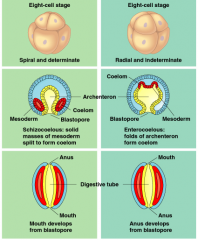
Which of these are characteristics are of Deuterostomes and which are of Protostomes?
|
|
|
• Turbellaria (Leptoplana - marine flatworm)
• Cestoda (Taenia pisiformis- tapeworm) • Trematoda (Opisthorchis sinensis - liver fluke) |
What Classes exist within Phylum Platyhelminthes?
|
|
|
• Clitellata (Lumbricus - earthworm, Hirudo- leech)
• Polychaeta (Nereis) • Echiura |
What Classes exist within Phylum Annelida?
|
|
|
• Polyplacophora (Katharina - chiton)
• Gastropoda • Bivalvia (Mytilus californianus - mussel) • Scaphopoda - tusk shell • Cephalopoda (Loligo opalescens - squid) |
What Classes exist within Phylum Mollusca?
|
|
|
• Chelicerata - spiders, scorpions, ticks, sea spiders
• Mandibulata - insects, myriapods, crustaceans • Trilobitomorpha - extinct |
What Subphyla exist within Phylum Arthropoda?
|
|
|
• Merostomata (Limulus - horseshoe crab)
• Arachnida - spiders, scorpions, ticks, mites • Pycnogonida - sea spiders |
What Classes exist within Subphylum Chelicerata?
|
|
|
• Myriapoda
• Insecta (Acheta - cricket) • Crustacea (Procambarus - crayfish) |
What Classes exist within Subphylum Mandibulata?
|
|
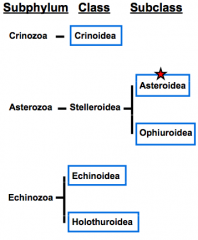
• Crinoidea - sea lilies and feather stars
• Stelleroidea - stars • Echinoidea (Strongylocentrotus - urchin) • Holothuroidea (Cucumaria miniata - sea cucumber) |
• What Classes exist within Phylum Echinodermata?
|
|
|
• Asteroidea (Pycnopodia - sunflower star)
• Ophiuroidea - brittle stars |
• What Subclasses exist within Class Stelleroidea?
|
|
|
• Patellogastropoda - true limpets ...no hole
• Vetigastropoda - keyhole limpets (Diodora aspera- keyhole limpet) • Caenogastropoda - whelks (Fusitriton oregonensis - hairy triton) • Heterobranchia - opisthobranchs and pulmonates (Lymnaea stagnalis - pond snail) |
What Subclasses exist within Class Gastropoda?
|
|
|
• Paranemertes - ribbon worms of the Phylum Nemertea
|
What species has the capabilities of everting it's long proboscis and piercing it's prey with the calcified stylet located at the end?
|
|
|
• Rhynchocoel
|
What is the fluid-filled sac containing Nemerteans proboscis called?
|
|
|
• Circular muscles contract against the fluid filled rhynchocoel causing it to shoot out everted and is pulled back in using it's retractor muscle.
|
How is the nermertine proboscis fired out and pulled back in?
|
|
|
• Circular followed by longitudinal muscle contractions as well as ciliated mucus movements - may use proboscis to pull them forward as well
|
How does nemertines locomotion take place?
|
|
|
• Phylum Nermetea, Genus Paranemertes peregrina
• A - ciliated epidermis • B - gonads • C - lateral blood vessel • D - intestine • E - circular muscles • F - outer longitudinal muscles • G - inner longitudinal muscles • H - nerve cord • I - middorsal blood vessel • J - rhynchocoel • K - proboscis |

Label A-K and name the Phylum and Genus this cross section belongs to.
|
|
|
• The feeding organ of Bryozoa is a circle (or horseshoe shaped in freshwater Bryozoans) of tentacles surrounding the mouth which are hollow with an extension of an anterior eucoelom - this is known as lophophoral coelom
|
What is a lophophore?
|
|
|
• Colonial (all but one)
• Sessile • Marine or freshwater • Erect/branching or flat/encrusting • Individual animals are called zooids • Zooids secret exoskeleton zooecium (zooecia) • Reproduce asexually by budding or sexually • Hermaphrodites • Freshwater species produce statoblasts |
Describe Bryozoa characteristics.
|
|
|
• Bugula californica
|
What is an example of an erect, branching colony of Bryozoa?
|
|
|
• Autozooids are feeding Bryozoa zooids which also produce gametes
|
What are autozooids?
|
|
|
• Heterozooids are defensive non-feeding, non-gametes generating Bryozoa zooids
• Avicularia zooids • Vibraculum zooids |
What are heterozooids?
|
|
|
• Phylum Bryozoa, Genus Bugula californica
• erect and branching zooids • have a calcified frontal zooicia • have defensive heterozooids - avicularia |

Name this animal's Phylum and Genus.
|
|
|
• Phylum Nemertea, Genus Paranemertes
|
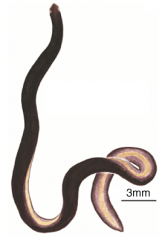
Name this animals' Phylum and Genus.
|
|
|
• Defensive heterozooid of Bryozoan Bugula californica
|
What is an avicularium?
|
|
|
• Statoblast - an overwintering bodies of freshwater bryozoans
• Chitinous protective covering • much like gemmules of freshwater poriferans |
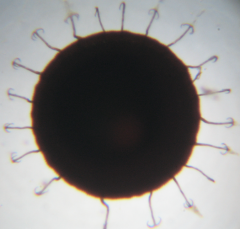
What is this?
|
|
|
• Phylum Mollusca, Class Polyplacophora, Genus Katharina tunicata (leather chiton)
|
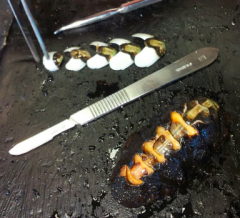
Name this animal's Phylum, Class, and Genus.
|
|
|
• Phylum Mollusca, Class Gastropoda, Subclass Vetigastropoda, Genus Diodora aspera (keyhole limpet)
|

Name this animal's Phylum, Class, Subclass and Genus.
|
|
|
• Similar: CaC03 shell secreted by mantle; ribbon of radular teeth; mantle cavity contains pallial organs (ctenidia, hypobranchial glands, and osphradia); bipectinate ctenidia; muscular foot on ventral side
• Distinct: - 8 shell valves - girdle - magnetite capped radula - dorso-ventrally flattened b/c of high current habitat - minimal cephalization due to sedentary lifestyle |
What are distinctive and similar characteristics of Class Polyplacophora?
|
|
|
• Two bipectinate ctenidia (filaments arising from both sides of central axis); perforated shell; two osphradia; two hypobranchial glands; free spawning of gamets, fertilization is external
• e.g. Diodora aspera (keyhole limpet) |
What are characteristics of Subclass Vetigastropoda?
|
|
|
• One monopectinate ctenidium; one osphradia; one hyprobranchial gland; water flows from left to right, over gills then anus on right side; fertilizaiton of eggs is internal then are deposited in egg capsules, swimming veliger larva hatches
• e.g. Fusitriton oregonensis (hairy triton - whelk) |
What are characteristics of Subclass Caenogastropoda?
|
|
|
• True ctenidia absent, have secondarily derived gas exchange structures (cerata); loss of calcified shell / minimal torsion; fertilize eggs internally the deposited as bethic egg capsules, veliger larva hatches
|
What are characteristics of Subclass Heterobranchia?
|
|
|
• Bipectinate ctenidia have gill filaments on both sides of the central axis, monopectinate only have one
|
What is the differences between molluscan bipectinate and monopectinate ctenidia?
|
|
|
• Patches of sensory epithelium in mantle cavity of molluscs, function as chemoreceptors which sense water quality
|
What are osphradia?
|
|
|
• Gland found commonly in Gastropoda which produces mucus
|
What are hypobranchial glands?
|
|
|
• Ctendia (gills), osphradia (sensory organs), and hypobranchial gland (mucus) are located in the mantle cavity
|
What do molluscan pallial organs consist of and where are they located?
|
|
|
• Gills found within the Phylum Mollusca
• All Classes but Cephalopoda have ciliated ctendium |
What are ctenidia?
|
|
|
• Cephalopodium - head and muscular foot
• Visceropallium - visceral organs covered by the mantle (=pallium) • Radula - rasping tongue like structure (absent in bivalves) |
What is the basic body characteristics of Phylum Mollusca?
|
|
|
• Hard calcium carbonate (CaCO3) inner part of Polyplacophora shell valves - white part tucked in the girdle
|
What is articulamentum?
|
|
|
• Tough protein (conchiolin), outer part of Polyplacophora shell valves - dark part in the middle
|
What is tegumentum?
|
|
|
• Shell 1 is anterior end; 8 is posterior
• A is the articulamentum • B is the tegmentum |
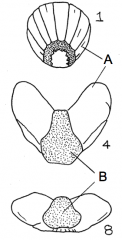
Name parts A and B of above shell valves and specific which is the anterior and posterior end?
|
|
|
• Cephalopoda:
• Gastropoda: at most one pair of dorsoventral shell attachment muscles; • Polyplacophora: couple pairs of dorsoventral attachment muscle; hemocoel and have an internal cavity not lined by mesothelia; reduced eucoelom found in pericaridum • Bivalvia: no radula; • Scaphopoda: no ctenidia, feeding by captacula, uncoiled shell, radula present |
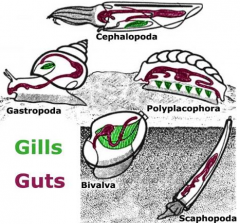
Compare and contrast.
|
|
|
• Mouth and pharynx of Phylum Mollusca
|
What is the buccal mass?
|
|
|
• They breathe air with a lung through pneumostome
|
How do Pulmonates (Subclass Heterobranchia) breathe differently than most other Gastropoda?
|
|
|
• Rather than ctenidia, they have secondly derived gas exchange structures called cerata or anal branchiae
|
How do Opisthobranchs (Subclass Heterobranchia) breathe differently than most other Gastropoda?
|
|
|
• A - Siphon canal
• B - Body whorl • C - Spire • D - Apex • E - Protoconch • F - Operculum |

Label A-F of above shell parts.
|
|
|
• Veliger
• A - foot • B - operculum • C - velar lobes • D - metatroch - upward stroke bringing food into food groove • E - food groove • F - prototroph - downward stroke - swimming and bringing in food • Planktonic & swimming |
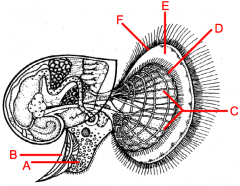
Name the above Gastropoda larva and label parts A-F.
|
|
|
• Protobranchia - deposit feeders
• Lamellibranches - suspension feeders • Septibranches - suction prey capture |
What feeding diversity exists within Phylum Bivalvia?
|
|
|
• Phylum Mollusca, Class Bivalvia, 'Lamellibranches', Genus Mytilus californianus
• use proteinaceous byssal threads secreted by gland in foot to secure themselves to rock shores |
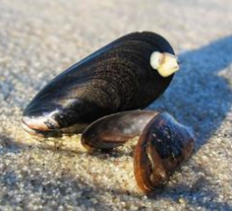
Name this animal's Phylum, Class and Genus.
|
|
|
• Phylum Mollusca, Class Cephalopoda, Subclass Coleoidea, Genus Loligo opalescens
|
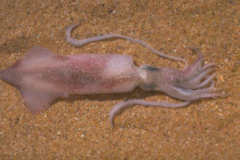
Name this animal's Phylum, Class, Subclass and Genus.
|
|

• Coleoidea - internal shell - squid, octopus, cuttlefish
• Nautiloidea - external shell - nautilus • Ammonoidea - extinct |
What Subclasses exist within Class Cephalopoda?
|
|
|
• life adapted for burrowing in sediment
• foot is laterally flattened • two shells hinged dorsally protecting animal from abrasive sediment or collapse • sensory structures along periphery of mantle fold |
What are the characteristics of Class Bivalvia?
|
|
|
• No ctenidia or gills of any kind - uses foot to circulate hemal fluid
• Tubular shell • Head burried in sediment - captacula grab food and bring into mouth • Has veliger larva stage |
What are the characteristics of Class Scaphopoda?
|
|
|
• Head-foot animals
• Have tentacles - modified foot • Active • Pelagic • Predatory |
What are the characteristics of Class Cephalopoda?
|
|
|
• deposit feeders using palp tentacles
• one bipectinate ctenidia with short gill filaments used for gas exchange only • have a taxodont hinge dentition • have siphon - which is a mantle fold elaboration |
What are the characteristics of Protobranches (Class Bivalvia)?
|
|
|
• suspension feeders
• ctenidia used in gas exchange as well as feeding organs and have become greatly enlarged • 3 different sets of cilia on ctendia for food capture, H20 flow, and gas exchange • have a heterodont dentition |
What are the characteristics of 'Lamellibranches' (Class Bivalvia)?
|
|
|
• predatory
• inhalent siphon sucks in smaller animals - sucks in by enlarging mantle cavity and creating negative pressure • highly modified ctenidia called a septibranch ctenidia which is capable of powerful suction of prey into siphon • have desmodont dentition |
What are the characteristics of Septibranches (Class Bivalvia)?
|
|
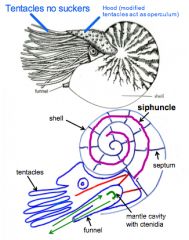
• Species have external shell divided in septa which is perforated for passage of the siphuncle which replaces fluid in the chambers with gas to provide buoyancy
|
What are the characteristics of Subclass Nautiloidea (Class Cephalopoda)?
|
|
|
• Species have internal shell that now functions as structural support or buoyancy control
|
What are the characteristics of Subclass Coleoidea (Class Cephalopoda)?
|
|
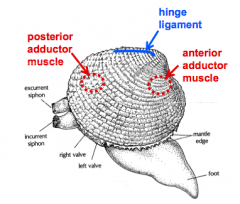
• A - pallial sinus (mantle cavity containing osphradia, ctenidia, and hyprobranchial gland)
• B - pallial line • C - anterior adductor muscle scar • D - posterior adductor muscle scar • E - hinge teeth |
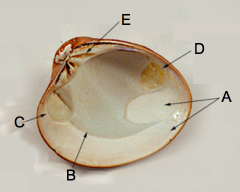
Label A-E of above Bivalvia shell.
|
|
|
• taxodont
• heterodont • desmodont |
What are the different types of hinge dentitions?
|
|
|
• Phylum Mollusca, Class Cephalopoda, Subclass Coleoidea, Genus loligo opalescens
• A - fin • B - chromatophores • C - mantle • D - olfactory groove • E - funnel • F - eye • G - arm • H - tentacle (with suckers) |
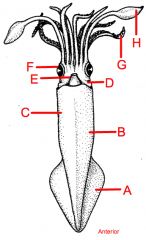
Name above species Phyla, Class, Subclass and Genus then label A-H.
|
|
|
• Female
• A - pen • B - digestive caecum • C - ovary & eggs • D - nidamental gland • E - ctenidia • F - external oviduct • G - ink sac • H - funnel retractor muscle • I - anus • J -cephalic retractor muscle |
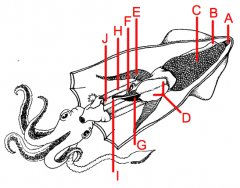
Label A-J of above Loligo opalescens and identify it as male or female.
|
|
|
• Male
• A - pen • B - digestive caecum • C - testes • D - seminal vesicle • E - penis • F - branchial hearts • G - ctendia • H - ink sac • I - anus |

Label A-I of above Loligo opalescens and identify it as male or female.
|
|
|
• The hinge ligament causes valves to gape open and contraction of the adductor muscles pull shelve valves closed
|
How do bivalves open and close?
|
|
|
• Lamellibranch ctenidia
• Mytilus californianus mussels have this gill • A - ciliated food groove • B - inner demibranch • C - outer demibranch |
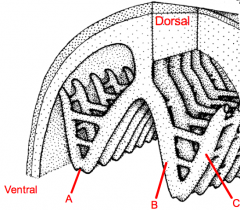
What type of gill is this? Label A-C and identify an animal with this type of gill.
|
|
|
• Heterodont - found in suspension feeders -'Lamellibranches'
• A - cardinal teeth • B - lateral teeth |
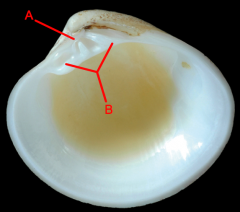
What kind of dentition is this and what are the teeth labeled called?
|
|
|
• Desmodont - ball & socket
• socket indentation on other valve is called a chondrophore |

What kind of dentition is this?
|
|
|
• Taxodont - found in deposit feeders - Protobranches
|
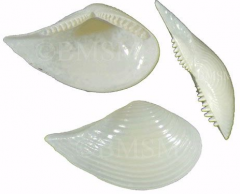
What kind of dentition is this?
|
|
|
• A - outer lobe secretes a tough protein (periostracum) and biominerals
• B - middle lobe houses sensory structures • C - inner lobe is muscles |
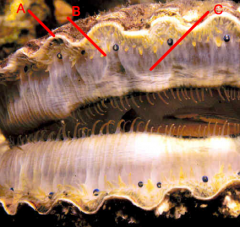
What is the functionality of each lobe of this scallop's mantle fold?
|
|
|
• Glochidia - parasitic freshwater bivalve larva (preys on fish)
|
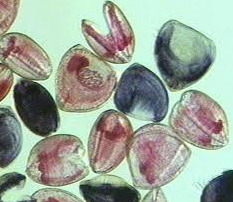
What is above animal?
|
|
|
• Glochidia - parasitic freshwater bivalve larva (preys on fish)
|
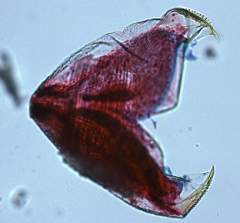
What is above animal?
|
|
|
• Avicularia heterozooid found in Bugula californica Bryozoa
|
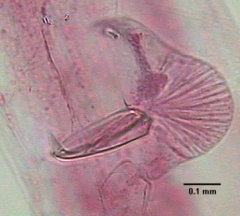
What is above animal?
|
|
|
• Phylum Mollusca, Class Scaphopoda
• A - gonads • B - nephridium (kidney) • C - digestive gland • D - stomach • E - anus • F - radula • G - ciliated mantle cavity • H - mouth • I - mantle cavity • J - shell • K - foot • L - captacula (tentacles) |
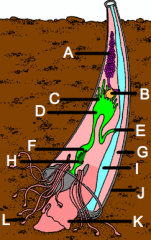
Identify above animal's Phyla and Class. Label A-L.
|
|
|
• Rhythmic foot contractions
|
How do Scaphopoda circulate their hemal fluid?
|
|
|
• Nautilus: external, heavily calcified shell with perforated septa for the passage of siphuncle
• Spirula: Coiled, calcifed internal shell separated by perforated septa for passage of siphuncle • Sepia (cuttlefish): porous calcarous internal shall - 'cuttlebone' provides buoyancy • Loligo (squid): chitinous pen for support |
What are the different kinds of "shells" found in Class Cephalopoda?
|
|
|
sjhfksjhgkshfgkh
|
stuff on other molluscas - kitten paws etc.
|
|
|
• Phylum Echinodermata, Class Holothuroidea, Genus Cucumaria miniata
|
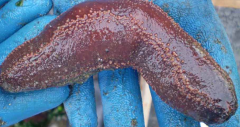
What is the above animal's Phylum, Class, and Genus?
|
|
|
• Phylum Echinodermata, Class Stelleroidea, Subclass Asteroidea, Genus Pycnopodia helianthoides
|
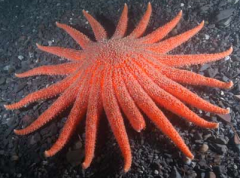
What is the above animal's Phylum, Class, Subclass and Genus?
|
|
|
• Phylum Echinodermata, Class Echinoidea, Genus Strongylocentrotus
|
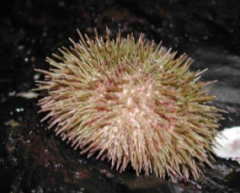
What is the above animal's Phylum, Class, and Genus?
|
|
|
• Phylum Echinodermata, Class Stelleroidea, Subclass Asteroidea, Pycnopodia helianthoides
• A - radial canal • B - madreporite • C - ampulla attached to radial canal via lateral canal (internal) • D - podium (external) • E - sucker (external) • F - tubefeet • G - stone canal • H - ring canal • I - Tiedemann's body • The system's water reservoir - Polian vesicles coming off the ring canal are not shown |
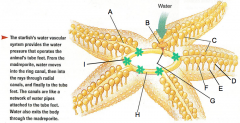
Label the parts of the above animal and identify it's Phylum, Class, Subclass and an example of a Genus name.
|
|
|
• Asteroidea ossicle
• a - Ambulacral ossicles • b - Position of the ambulacral zone • c - Plates of the endoskeleton • n - Nerve-cord. • The dotted lines show the tube-feet proceeding from the ambulacral zone. • Ossicles linked by collagen |
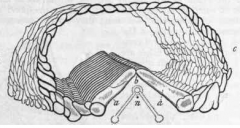
What does the above image represent?
|
|
|
• Holothuroidea (sea cucumbers) filter perivisceral fluid
|
What Class of Echinodermata does not filter sea water through it's madreporite?
|
|
|
• Specialized porous ossicle which bring sea water into the water vascular system of Echinodermata (except in Class Holothuroidea which uses it's to filter internal perivisceral fluid)
|
What is a madreporite?
|
|
|
• Water vascular system
• Ossicles • Tube feet for feeding, gas exchange, and excreting ammonia, and locomotion for some Classes • Mutable connective tissue under control from the nervous system or hormones • No segmentation, no head, no brain • All are marine |
What are some characteristics of Phlyla Echinodermata?
|
|
|
• Have claw-like cirri which attach to substrate of allow for crawling
• Have arms with many side branches called pinnules • Tube feet come off pinnules in triplets - 2 for capture of food and one to transfer to ciliated groove for feeding |
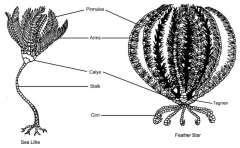
What are characteristics of Class Crinoidea (Phylum Echinodermata)?
|
|
|
• A - cardiac stomach
• B - pyloric duct • C - pyloric caeca (storage of nutrients) • D - mouth • E - esophagus • F - pyloric stomach (attached to pyloric ducts) |
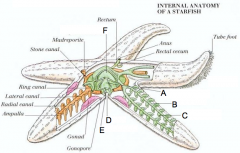
Label A-F of above Asteroidea digestive system.
|
|
|
• Papulae - dermal branchiae projections
|
Besides the tube feet how else do Stelleroidea exchange gases and release ammonia?
|
|
|
• Sea urchins - Strongylocentrotus
|
What is an example of a regular Echinoidea?
|
|
|
• Heart urchins, sea biscuits, and sand dollars
• Anus has shifted to side |
What are examples of irregular Echinoidea?
|
|
|
• A - oral end
• B - aboral end • C - spines • D - buccal tube feet • E - mouth • F - ambulacral plates (dbl column) • H - interambulacral plates (dlb column) • I - anus • J - gonopore • K - perforations for tube feet (ambulacral) • L - madreporite |
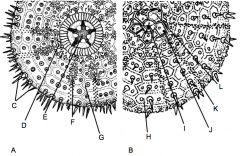
Label A-L of above Echinoidea.
|
|
|
• A - intestine
• B - radial canal • C - ampullae • D - esophagus • E - anus • F - madreporite • G - gonopore • H - madreporite canal • I - radial canal • J - gonads • K - test • L - ring canal (polian vesicles not labelled) • M - ossicles • N - Aristotle's lattern • O - pharynx • P - peristomial membrane • Q - mouth w/ teeth |
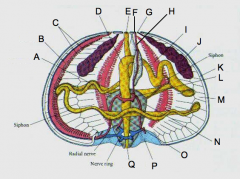
Label above internal anatomy of Echinoidea (A-Q).
|
|
|
• Aristotle's latern
• found in Phylum Echinodermata, Class Echinoidea, Genus Strongylocentrotus • A - tooth • B - epiphysis • C - compass • D rotula • E - pyramid • F - tooth |

Name the above structure, label A - F and say what animal this is found in.
|
|
|
• Pedicellariae
• found in Phylum Echinodermata, Class Stelleroidea & Echinoidea • Asteroidea pedicellariae have 2 jaws • Echioidea pedicellariae have 3 jaws |
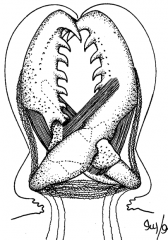
What is above structure and what animals are these found in?
|
|
|
• 2 rows of dorsal ambulacra with less pronounced podia on top dorsal side - longitudinal muscle lie below each
|
What is the bivium seen in Class Holothuroidea?
|
|
|
• 3 rows of ventral ambulacra with more pronounced podia on bottom ventral surface - longitudinal muscle lie below each
|
What is the trivium seen in Class Holothuroidea?
|
|
|
• Cloaca is a posterior opening and in the Class Holothuroidea it is used for gas exchange, connected to respiratory trees
• Intestinal sphincter contracts while anal sphincter opens - cloaca suspensor muscles contract to widen and taken in oxygenated sea water - anal sphincter closes and water travels up to respiratory tress for gas exchange |
What is a cloaca and what animal has one?
|
|
|
• Phylum Echinodermata, Class Echinoidea, Genus Cucumaria miniata
• A - anus • B - cloaca • C - cloaca suspensor muscles • D - intestine • E - respiratory tree • F - longitudinal muscle band • G - ampullae • H - internal madreporite (circulates coelomic fluid rather than seawater like other echinoderms) • I - stone canal • J - retractor muscles • K - aquapharyngeal bulb • L - buccal podia • M - mouth • N - ring canal • O - esophagus • P - polian vesicles • Q - gonads • R - stomach |
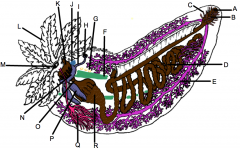
Label A - R of above animal's anatomy and give the Phylum, Class, and Genus example.
|
|
|
• Holothuroidea free floating ossicle
|

What does the above image represent?
|
|
|
• Tube feet suckers are used to pull animals across rocky substrates
|
What is the form of locomotion found in Subclass Asteroidea (Class Stelleroidea)?
|
|
|
• Crinoidea walk on ciri or occasionally crawl on arms - they can also swim with their arms in an undulating motion
|
What is the form of locomotion found in Class Crinoidea?
|
|
|
• Regular echinoids use spines and sucks on tube feet
• Irregular echinoids burrom & move with spines only - tube feet used primarily for gas exchange - petaloid podia |
What is the form of locomotion found in Class Echinoidea?
|
|
|
• Locomotion occurs by arms rowing with traction being provided by lateral spines
• Tube feet do not have suckers on them and are used only for gas exchange, feeding and sensory mechanisms |
What is the form of locomotion found in Subclass Ophiuroidea?
|
|
|
• Sea cucumbers may utilize suckers on tube feet to crawl but primarily utilize their longitudinal/circular muscles for peristaltic movement
• Tube feet usually used for gas exchange |
What is the form of locomotion found in Class Holothuroidea?
|
|
|
• Respiratory trees connected to the cloaca to take dissolved oxygen in the water - breathe out their ass...
|
What is the mechanism by which Class Holothuroidea exchange gas?
|
|
|
• Sea stars utilize papulae which cover their surface - but also utilize tube feet
|
What is the mechanism by which Subclass Asteroidea exchange gas?
|
|
|
• Utilize tube feet
• Irregular echinoids have petaloid podia in a flower shape on aboral surface • Epidermal epithelium and mesothelium is ciliated to keep oxygenated water flowing over surfaces |
What is the mechanism by which Class Echinoidea exchange gas?
|
|
|
• Cuticle which is molted as animal grows (=ecdysis)
• Lack motile cilia |
What are the characteristics shared within the Ecdysozoan group?
|
|
|
• At some stage in their development they all a notochord, dorsal hollow nerve cord, pharyngeal perforations, and a post-anal tail
|
What are the characteristics of the Phylum Chordata?
|
|
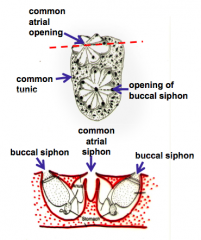
• Asexually bud
• Each social module has it's own incurrent and excurrent siphon but is connected via stolens • Colonial modules have separate buccal siphons and mouths but share a tunic and atrial siphon |
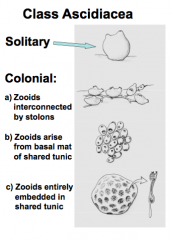
What are the characteristics of social/colonial ascidians (Phylum Chordata, Subphylum Urochordata, Class Ascidiacea)?
|
|
|
• Phylum Chordata, Subphylum Urochordata, Class Ascidiacea - this is an ascidian tadpole larvae
• A - pharyngeal slits • B - post-anal tail • C - notochord • D - hollow dorsal nerve cord |

What is the above animal larva called? Label A - D.
|
|
|
• Phylum Onychophora, Genus Peripatus
• Velvet worm |
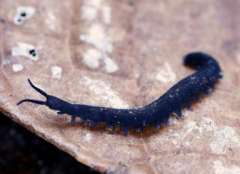
What is the above animal's Phylum and Genus?
|
|
|
• Phylum Onychophora, Genus Peripatus
• A - antenna • B - oral papilla - shoots out sticky glue strand • C - mouth • D - jaw |
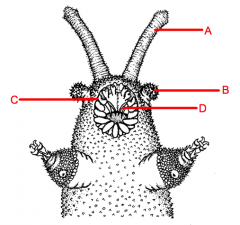
Name this animal's Phylum and Genus and label A - D. What are the differences and similarities between this Phyla and Phyla Arthropoda?
|
|
|
• Legs
|
What are the jaws and oral papilla of Phylum Onychophora modified from?
|
|
|
• A - Larvae infect new host by penetrating foot and entering into circulatory system
• B - Larvae carried to heart through blood and enter the lungs - migrate to pharynx - host reacts to tickle in throat, coughs, and larvae is swallowed • C - Larvae arrive attach to small intestine, mature (adult) and release eggs which exit in feces • D - Damp soil triggers L1 to hatch and emerge onto soil • E - Larvae mature (L2-L3) and source out a new host |
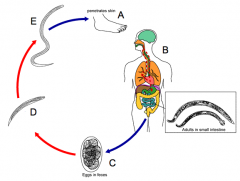
Describe the above hookworm life cycle (Phylum Nematoda).
|
|
|
• Have a cuticle (but it is significantly less thin)
• Legs have terminal claws • Hemocoel • Trachaea • Jaws and oral papilla modified legs |
What do Phyla Onychophora have in common with Phyla Arthropoda?
|
|
|
• Legs are unjointed
• Segmentation • Hydrostatic skeleton • Oral papillae |
What traits do the Phyla Onychophora have which is not seen in Phylum Arthropoda?
|
|
|
• Hard cuticle which is molted periodically (=ecdysis)
• Waxy cuticle surface layer protects animals from dehydrating by evaporation • Bilaterally symmetric • Body segmentation (=metamerism) • Tagmatization • Open circulatory system • Complete digestive tract • Reduced coelom |
What are characteristics associated with Phyla Arthropoda?
|
|
|
• Specialisation of metameres in animals, particularly arthropods, into distinct body regions, each known as a tagma
|
What is tagmatization?
|
|
|
• 2 body tagma - Prosoma & Opisthosoma
• Prosoma appendages include: - 1st pair chelicerae used for feeding - 2nd pair pedipalps - 4 pairs of walking legs • Opisthosoma appendages vary between classes |
What are characteristics of Subphyla Chelicerata?
|
|
|
• Phylum Arthropoda, Subphylum Chelicerata, Class Meostomata, Genus Limulus
• A - chelicerae • B - pedipalp • C - walking legs • D - 5th walking leg - not chelated; used for cleaning • E - chilarium • F - book gills (covered by opercula) • G - telson • H - simple eye • I - carapace • J - compound eye • K - simple, lateral photoreceptor • L - prosoma • M - opisthoma |
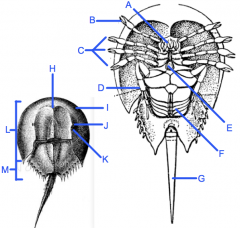
Name the above animal's Phylum, Subphylum, Class, and Genus and label A-M.
|
|
|
• Spiny podomere at the base of each horseshoe crab's walking legs
• lacks jaws to chew its food, so as it moves, the gnathobases work to tear and shred worms, clams or any other inverts it picks up as it sift through the sand |
What are gnathobases and where are they found?
|
|
|
• No
|
Is the telson (tail) of Phyla Arthropoda a true metamere (segment)?
|
|
|
• Scorpion chelicerae are pincers rather than fangs
|
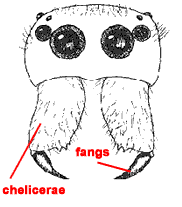
How do the chelicerae of spiders (as shown above) differ from those of scorpions?
|
|
|
• Capitulum
|
What special feeding structure is found in ticks which acts to pentrate the host and anchor it during feeding?
|
|
|
• Pair of antennae (sensory)
• Pair of mandibles (feeding) • 1st pair of maxillae (accessory feeding) • 2nd pair of maxillae ( accessory feeding) • Crustaceans have a 2nd pair of antennae |
What are characteristics of Subphyla Mandibulata?
|
|
|
• Predators
• Fast running carnivores - long legs • 1st pair of trunk appendages are poison claws • Epicuticle is H20 permeable and it's spiracles do not close |
What are characteristics of Chilopoda (centipedes)?
|
|
|
• Slow moving
• Herbivores • Diplosegments • 1st and 2nd pair of maxillae are fused (=gnathochilarium) |
What are characteristics of Diplopoda (millipedes)?
|
|
|
• Phylum Nematoda, Genus Ascaris lumbricoides
• A - cuticle • B - hypodermis • C - seminal vesicle • D - excretory system (inside lateral nerve cord) • E - vas defera • F - intestine • G - cytoplasmic muscle cell processes • H - longitudinal muscles • I - testes • J - lateral nerve cord (excretory system inside) • K - pseudocoel • L - oviduct • M - uterus (X2) • N - ovaries |
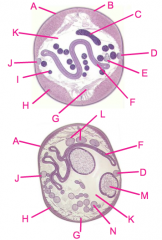
What is above animals Phyla and Genus? Label A - and determine which cross-section is male and which is female.
|
|
|
• Phylum Arthropoda, Subclass Chelicerata, Class Pycnogonida
• A - chelicera • B - proboscis • C - pedipalp • D - opisthosoma • E - eye |
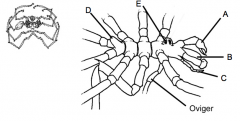
Label above diagram and name the animal's Phylum, Subclass, and Class.
|
|
|
• Malacostraca - krill, shrimp, mantis shrimp, crayfish, crab
• Copepoda - copepods/sea lice • Cirripedia - barnacle |
What Subclasses exist within Class Crustacea?
|
|
|
• Decapoda - shrimp, crayfish, crab
• Euphausiacea - krill • Stomatopoda - mantis shrimp |
What Orders exist within Subclass Malacostraca?
|
|
|
• Caridea - shrimp
• Anomura - hermit crabs & squat lobster • Brachyura - crabs • Astacidea - crayfish & lobsters |
What Infraorders exist within Order Decapoda?
|
|
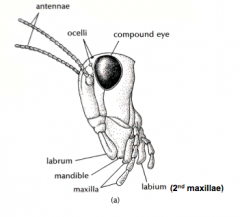
• Phylum Arthropoda, Subphylum Mandibulata, Class Insecta, Genus Acheta domesticata
• A - antenna • B - compound eye • C - mandible • D - maxillae • E - maxillae • F - labrum (upper lip) & labium (lower lip) |
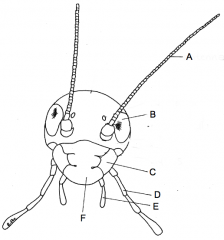
What is above animal's Phylum, Subphylum, Class and Genus? Label A-F.
|
|
|
• Spiracles
|
What are the breathing pores along the sides of crickets called?
|
|
|
• Tympanum
|
What is the sound reception organ located on the first abdomen segment of crickets called?
|
|
|
• A - prothorax
• B - mesothorax • C - metathorax • D - cerci • E - ovipositor |

Label A - E.
|
|
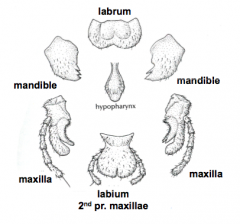
• A - labrum
• B - hypopharynx • C - mandible • D - maxilla • E - palp • F - labium |
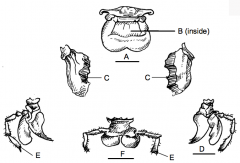
Label above mouthparts of the cricket.
|
|
|
• Cricket mouthparts are for chewing and biting
• Houseflies have sponging mouthparts • Butterflies have sucking mouthparts • Mosquitoes have piercing and sucking mouthparts |
How do the mouthparts of crickets differ from those of a housefly, mosquito, and butterfly?
|
|
|
• Tracheal tubules with closable spiracles
|
How does Class Insecta breath?
|
|

• Malpighian tubules excrete a nearly dry solid form of uric acid
|
How does Class Insecta excrete waste?
|
|
|
• Ametabola life cycle
• primitive wingless adult insects (ie. silverfish) resemble young except for size and developed sex organs |
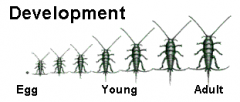
What is this an example of?
|
|
|
• Hemimetabola
• nymphs (instars) somewhat resemble adults but start off with wing pads (=exopterygote) which develop (inflate with hemolymph) into full wings after final molt |
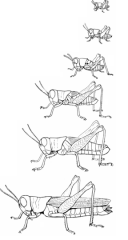
What is this an example of?
|
|
|
• Holometabola
• worm-like larvae entirely unlike adults, they undergo a complete metamorphosis where wings develop from internal wing pads (=endopterygote) |

What is this an example of?
|
|
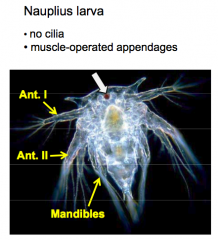
• 2 or 3 tagmata - head, thorax, abdomen
• 2 pair antennae • biramous appendages • nauplius larva |
What are characteristics of Class Crustacea?
|
|
|
• Caudal furca
• They also have biramous appendages |
What is the forked tail of Subclass Copepoda called?
|
|
|
• Cirri
|
What are the thoracic appendages which collect food of Subclass Cirripedia (barnacles) called?
|
|
|
• Thoracopods (biramous & highly setous)
|
What are the cirri appendages found on Cirripedia called?
|
|
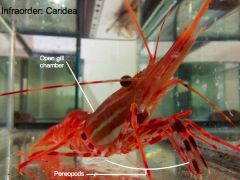
• Delicate, slender pereopods for perching on substrate
• Large, muscular abdomen • Well developed pleopods for swimming • Open gill chambers • Chelate endings of pereopods used to clean gills • Holopelagic (only pelagic lifestyle) or Pelago-benthic (both pelagic and benthic) |
What are characteristics of shrimp (Phylum Arthropoda, Subphylum Mandibulata, Class Crustracea, Subclass Malacostraca, Order Decapoda, Infraorder Caridea)?
|
|
|
• A - cephalothorax
• B - head (5 appendages) • C - thorax (8 appendages) • D - abdomen (6 appendages) • E - carapace • F - thoracopods (8 pairs) (maxillipeds and pereopods) • G - pleopods (5 pairs) • H - telson • I - uropod (1 pair - endopodite & exopodite) |
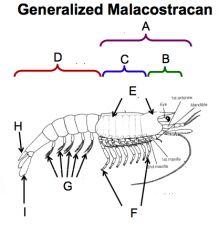
Phylum Arthropoda, Subphylum Mandibulata, Class Crustacea, Subclass Malacostraca
|
|
|
• funnel of ciliated tentacles surrounding the mouth of Bryozoans
|
What is a lophophore?
|
|
|
• A - retractor muscles
• B - zooid wall (which is surrounded by zooecium) • C - operculum • D - mouth • E - lophophore tentacle • F - lophophoral coelom • G - tentacular sheath • H - anus • I - avicularia (defensive heterozooid) • J - gut |
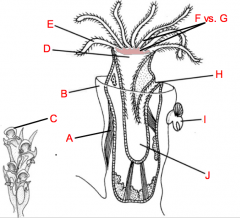
Label above diagram A-J of Bryozoan zooid.
|
|
|
• nutrients transfered through shared perivisceral coelom (mesodermal)
|
How are nutrients transfered between zooids in a Bryozoan colony?
|
|
|
• Two; lophophoral coelom and the perivisceral coelom
|
How many coelomic compartments are found in Bryozoans?
|
|
|
• Monobryozoon
• live between sand grains and walk around/maintain position on rhizoid-like projections |
What genus of Bryozoan is solitary?
|
|
|
• Diffusion - no specialized organs
• the small size of individual zooids allows for this |
How do Bryozoans exchange gas, excrete waste, and circulate coelom fluid?
|
|
|
• Ventral - the orientation of the lophophore altered to this position
|
What side of the encrusting colonies of Bryozoan zooecium is facing up?
|
|
|
• The asexual pattern of budding
|
What determines the shape of Bryozoan colonies?
|
|
|
• Stoloniferous - individual zooids connected by a stolon
• Encrusting - flat, ventral side up • Erect - flat blades or branched fronds |
What type of colony forms exist within Phylum Bryozoan?
|
|
|
• Heterozooids found within Phyla Bryozoa
• whip-like projections • sweep off debris • may be used to "walk" on - in this case the bryozoans are found to have a colony-wide nervous system |
What are vibraculum?
|
|
|
• Sexually - hermaphroditic (but some dioecious) colonies; sperm mature in perivisceral coelom and escape through pores in the lophophoral tentacles; eggs brooded then free-swimming ciliated larvae colonize new substrates
• Asexually - budding |
How does the Phyla Bryozoan reproduce?
|
|
|
• mass of semi-degraded Bryozoan zooids
• period of degeneration of lophophore, retractor muscles and gut as a cycle of regeneration - possibly because of a build up of ammonia which is merely diffused • zooecium, perivisceral coelom, and epidermal epithelium dont degenerate |
What are brown-bodies?
|
|
|
• Heterozooids - avicularia and vibracula
• Colonialism - whole colonies rarely wiped out • Chemical defense - bryostatin (synthesized by symbiotic bacteria) found in adults and Bugula larvae is distasteful to predators • Calcification of frontal membrane (requires ascus) |
What are the defensive strategies of Phylum Bryozoan?
|
|
|
• Un-calcified frontal membrane: protractor muscles attach to flexible membrane and when contracted the frontal membrane is pulled coelomic pressure increases, forcing out the tentacles
• Calcified frontal membrane: protractor muscles attached to ascus sac and when muscles contract the sac brings in seawater through a pore, inflation of the ascus works the same to increase coelom pressure |
How is the lophophore extended from Bryozoan's calcified zooecium (with and without a calcified frontal membrane)?
|
|
|
• Sea slugs which use their radula to slice open frontal membrane and suck out fluid
|
Give an example of Bryozoan predators?
|
|
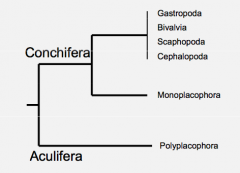
• A - Gastropoda
• B - Bivalvia • C - Scaphopoda • D - Cephalopoda • E - Polyplacophora |
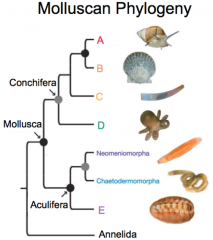
Fill in the Classes blanks A-E.
|
|
|
• 1 - mouth
• 2 - intestine • 3 - anus • 4 - amphids (chemosensory) • 5 - muscular pharynx • 6 - circumpharyngeal nerve ring • 7 - mid dorsal nerve cord • 8 - mid ventral nerve cord • 9 - cuticle • 10 - syncytial epidermal epithelium • 11 - sphycter muscle (around rectum) |

Label 1-11 of above Nematode.
|
|
|
• Longitudinal muscles only
|
What kind of muscles do Nematoda have?
|
|
|
• Longitudinal muscles only
• Syncytial epidermis • Muiltilayered, collagenous cuticle (which is molted 4 times) • Eutely |
What are characteristics of Phylum Nematoda?
|
|
|
• Hydrostatic skeleton (pseudocoel) maintained under high pressure
|
What kind of "skeleton" may be found in Nematodes?
|
|
|
• Edysozoa
|
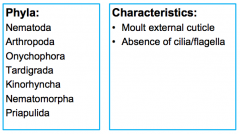
What Superphylum do these Phyla belong to?
|
|
|
• By gulping large volumes of water with their muscular pharynx thus carrying food through to intestine
|
How do Nematodes swallow food?
|
|
|
• Asexually - some capable of parthenogenesis (egg unfertilized)
• Sexually - most are dioecious and internal fertilization occurs |
How do Nematodes reproduce?
|
|
|
• Four times
• Egg -> juvenile #1 (L1) -> molt #1 -> juvenile #2 (L2) -> molt #2 -> juvenile #3 (L3) -> molt #3 -> juvenile #4 (L4) -> adult • L1-L4 stand for larvae 1-4 although their are no specialized characteristics of the juveniles (direct development) therefore not technically larvae |
How many times do Nematodes molt?
|
|
|
• Ceonorhabditis elegans (nematode)
• tiny, short generation time (3 days), hemaphroditc, eutely • entire cell lineage is known • synaptic connections between all neurons have been mapped • entire genome has been sequenced • currently looking at gene expression and behavior |
What is a model organism for developmental genetics?
|
|
|
• Monophyletic
|
Are Arthropods now thought to have monophyletic or polyphyletic ancestry?
|
|
|
• No, Nematodes are now found to be the sister group
• It is because of this that Arthropods are not likely derived from eucoelomates |
Are Annelids a sister group to Arthropods?
|
|
|
• The formation of groups of metameres into body regions with functional differences
• seen in Arthropoda |
What is tagmosis?
|
|
|
• The fact that Arthropods have metameres similar to the segmentation found in Annelids
|
What was believed to link Arthropods to Annelids?
|
|
|
• A - epicuticle - made of lipoproteins and wax to prevent desiccation
• B - exocuticle - typically more sclerotized than endocuticle • C - endocuticle • D - epidermis • E - make up procuticle - made of chitin (N-acetylglucosamine polysaccharide) and protein (cross-linked sclerotization) |
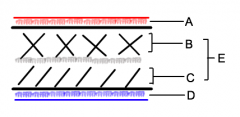
Label parts A-E of above Arthropoda exoskeleton structure and identify what each part is composed of.
|
|
|
• Protection
• Support and shape maintenance • Minimize desiccation • Facilitates movement (joints between sclerite sections) |
What is the function of the Arthropoda exoskeleton?
|
|
|
• Articular / arthropodial membrane
|
What is the section between sclerites where a joint lies in Arthropods termed?
|
|
|
• A - articulate / arthropodial membrane
• B - extensor muscle • C - flexor muscle • D - article (podomere) |
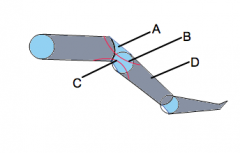
Name parts of above Arthropod appendage A-D.
|
|
|
• A - dorsal sclerite tergum
• B - lateral sclerite pleuron • C - ventral sclerite sternum |
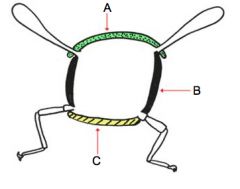
Identify A-C of above Arthropoda cross-section.
|
|
|
• Extensor muscle (dorsal)
• Flexor muscle (ventral) |
What constitutes the movement of appendages in Arthropods by antagonistic muscle bands?
|
|
|
• 1 - sensory
• 2 - mouthparts • 3 - prey capture • 4 - crawling • 5 - swimming • 6 - escape behavior |

Identify what sections 1-6 are used for.
|
|
|
• A - ostium
• B - dorsal blood vessel / heart chambers • C - alary muscles |
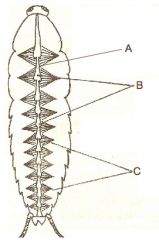
Identify parts of above blood vascular system found in Arthropods.
|
|
|
• DBV is closed at the posterior end and open at the anterior end
• In the abdomen, DBV is the heart, which is divided into chambers separated by small valve-like openings called ostia, through which blood enters the heart • Each chamber has a pair of alary muscles which expand and contract to facilitate the flow of haemolymph through the heart • The section of the dorsal vessel after the heart does not possess valves or musculature but is instead simple tube called the aorta which facilitates transport of the haemolymph to the head (anterior end), where it empties into the body cavity • Haemolymph from the body cavities enters the ostia when the alary muscles of the heart chambers relax • When the alary muscles contract the ostia close preventing the haemolymph from returning to the body cavities • Haemolymph moves through the DBV by continual peristaltic contractions of the alary muscles. The contractions begin at the posterior chamber of the heart and continue forward, pushing the haemolymph anteriorly, toward the aorta • Continual pumping pushes the haemolymph through the aorta and into the head, where it bathes the organs and muscles, then flows back down the body via a series of cavities until it reaches the abdomen and re-enters the heart |
How does the insect circulatory system of insects work?
|
|
|
• Arthropods - saccule was once thought to be a highly shrunken eucoelom
• Saccule may also go by the names of antennal gland, green gland, or coxal gland (in aquatic arthropods only) |
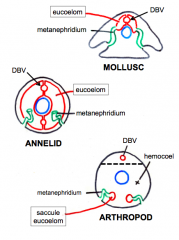
Compare and contrast the above three Phyla.
|
|
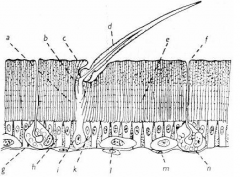
• Mechanoreceptors - sensory hairs innervated by neurons beneath epidermis
• Chemoreceptors - rare case of openings in exoskeleton attached to neurons through pores |
What kind of sensilla do Arthropods have found within the exoskeleton?
|
|
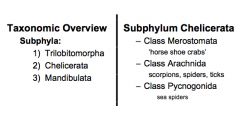
|
What Classes exist within Subphyla Chelicerata?
|
|
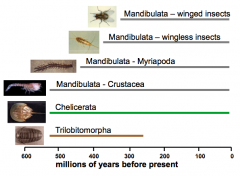
|
In what order did Arthropods Subphyla first appear?
|
|
|
• Phylum Arthropoda, Subphylum Chelicerata, Class Merostomata, Genus Limulus
• A - prosoma • B - opisthosoma • C - telson - not a true metamere |
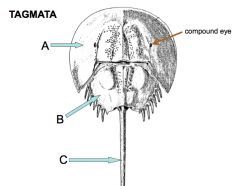
Name above Tagmata A-C and identify organisms Phyla, Subphyla, Class and Genus. Which of these Tagmata is not a true metamere?
|
|
|
• Pincers - "opposable thumb" like
• Not a true characteristic of chelicerates because many mandibulates have these as well |
What are chelate appendages?
|
|
|
• They have a set of compound eyes - ocelli are usually found in Chelicerates
|
What is unique about the eyes of Class Merostomata to it's Subphyla Chelicerata?
|
|
|
• Tracheal tubules
• Book lungs - O2 enters through spiracle • can have one or the other or both |
How does Class Archanida exchange gas?
|
|
|
• A - chelicerae
• B - pedipalp • C - telson modified with venom gland and stinger • D - pectine - mechanoreceptors (modified appendages off the opisthosome) • E - spiracle of book lung • F - anus |
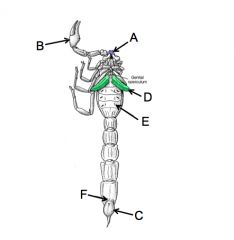
Lable A-F of above scorpion and name it's Phylum, Subphylum, and Class.
|
|
|
• Modified sensory structures (mechano- and chemoreception)
|
What are the pedipalps of spiders?
|
|
|
• Modified for delivering venom - either neurotoxins or hemocytic agents
• Fangs which puncture skin are of heavily sclerotized material |
What are the chelicerae of spiders?
|
|
|
• Spinnerets are found on spiders - made up of many spigots
• Pectine (mechanoreceptors) are found on scorpions |
What appendages are found on the opisthosoma of Class Arachnida?
|
|
|
• Sperm transfer - all spiders
• Egg cases • Prey capture • 'Aqualung' - aquatic spiders • 'Ballooning' - juvenile spiders |
What are the functions of spider silk?
|
|
|
• Phylum Arthropoda, Subphylum Chelicerata, Class Arachnida
• A - hypostome; spiny "tooth" • B - chelicerae • C - pedipalp |
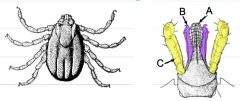
Identify parts A-C of above mite and give it's Phylum, Subphylum and Class.
|
|
|
• Sucking
|
What are mite and tick's mouthparts modified for?
|
|
|
• Males use them to hold onto egg mass to brood
|
What is the ovigerous legs of Class Pycnogonida used for if they are present on the sea spiders?
|
|
|
• A - ctendia
• B - foot • C - dorso-ventral muscles attached to shell • D - mantle cavity • E - mantle • F - CaCO3 shell (biomineralized) |
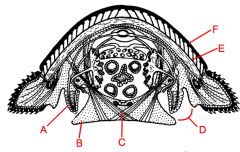
Label A-F of above Polyplacophora.
|
|
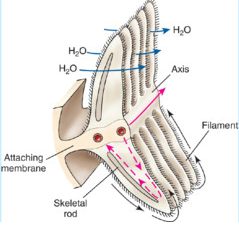
|
How does a ctenidia circulate O2?
|
|
|
• A - mouth
• B - buccal cavity with radula • C - stomach • D - dorsal blood vessel (much more muscular than annelid DBV)** • E - gonads • F - intestine • G - heart** • H - pericardial cavity** • I - anus • J - metanephridium pore • K - gonopore • Circumpharyngeal nerve ring has 6 ganglia - 2 cerebral ganglia, 2 with visceropallial nerve cords extended dorsally, and 2 pedal nerve cords extended ventrally |
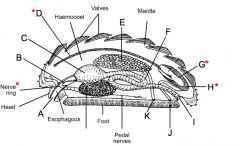
Label A-K of above Polyplacophora.
|
|
|
• Class Monoplacophora
• has multiple pairs of dorsoventral attachment muscles, gills, and metanephridia |
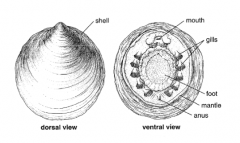
What is the above Class of Phylum Mollusca?
|
|
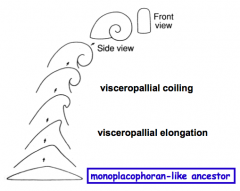
• It is just a covering while all others can retract their bodies fully into theirs
|
How do Polyplacophora and Monoplacophora shells differ compared to other Molluscan shells? How are shells believed to have developed from ancestral species?
|
|
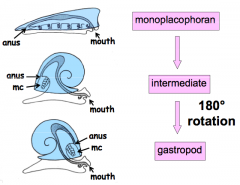
• Reduction in shell apperature, number of dorsoventral shell muscle attachments, and number of ctenidia
• 180º rotation of visceropallium with respect to cephalopodium during hypothetical intermediate stage |
What is torsion?
|
|
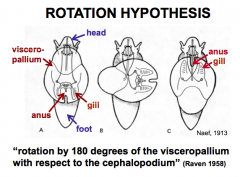
• Hypothesis depends on existence of hypothetical intermediate
• Diodora aspera veliger larva shows torsion after 24hrs though |
What is the rotation hypothesis and how does it prove that torsion occurred in
|
|

• Prosobranchia have now been sub-divided into Patellogastropoda (true limpets), Vetigastropoda (abalone, keyhole limpet), and Caenogastropoda (majority of shelled gastropods)
|
What was the classic hypothesis of taxonomic grouping of the Class Gastropoda? How has it changed now?
|
|
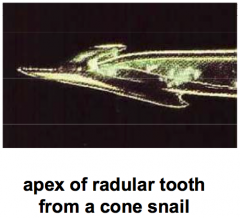
• Hollow radula harpoon containing a cocktail of small peptide neurotoxins which target ion channels and paralyze the prey upon contact with the cone snail's proboscis
|
What special adaptations does the predatory genus Conus (cone snail) use to capture it's prey?
|
|
|
• Defensive chemicals
- dorsal glands which secret unpalatable toxins - sequester chemicals from prey - de novo synthesis? • Cerata - use of mucus to discourage discharge of cnidocytes in prey allows them to consume, sequester, and store cells in cnidosacs (found at the tip of cerata) and can expel them when threatened • Autotomy - chuck parts of their bodies • Coloration - imitation of prey pigments • Escape behavior - "swimming" although highly reliant on current in the water versus its body fluctuations |
What are the defensive strategies of the Opisthobranchia (Class Gastropoda) which have secondarily lost or reduced their shell?
|
|
|
• 'Lungs' - open and closing of pneumostome helps reduce desiccation
• Ammonia has been converted to uric acid because it cannot simply diffuse ammonia like in marine species • Aestivation - can tolerate dehydration and will rapidly rehydrate by H20 transport across pedal epithelial epithelium |
How have the Pulmonata (Class Gastropoda) adapted to terrestrial life?
|
|
|
• Patellogastropoda and Vetigastropoda broad cast spawn
• Caenogastropoda and Heterobranchia (Pulmonates and Opisthobranchia) lay eggs • Also note - Heterobranchia are hermaphroditic while all others are dioecious |
Which clades of the Class Gastropoda broadcast spawn and which lay encapsulated eggs?
|
|
|
...
|
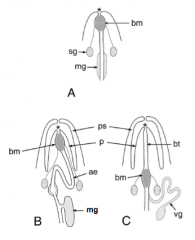
Explain the difference between A-C.
|
|
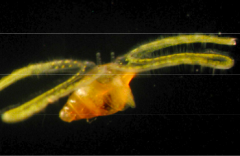
• Larvae undergo metamorphosis and loss of prototrochal ciliary band occurs
|
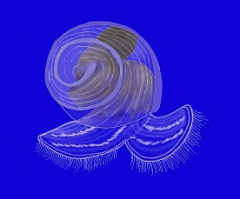
How does the cone snail larvae compare to the normal Gastropoda veliger larvae as seen above?
|
|
|
• A state of dormancy - seen in Pulmonata
|
What is Aestivation?
|
|
|
• Head: 5 segments
• Thorax: 3 segments (pro- meso- metathorax each have one pair of legs and may be mesothoracic & metathoracic wings) • Abdomen: 11 segments |
How many segments are associated with each of the 3 body tagmata of Class Insecta?
|
|
|
• Minimization of water loss
- waxy epicuticle - malpighian tubules excrete uric acid - H20 reabsorption in rectum - dry wastes - tracheal tubules and closable spiracles • Thermalregulation - behavioral (basking, shade seeking, burrowing, silting, migration) - structural (furry setea provide insulation) - physiological (shivering, freeze tolerance and freeze avoidance - AFP: antifreeze proteins) • Flight - escape - dispersal - increase genetic diversity - niche diversification (dispersal) - oviposition site location |
What terrestrial adaptations has Class Insecta developed?
|
|
|
• Wingless insects - wings secondarily lost
|
What are apterygotes?
|
|
|
• Winged insects
|
What are pterygotes?
|
|
|
• Malpighian tubules
|
Where is the "glow" of gloworms produced?
|
|
|
• Anitbodies against nubbin protein is found in developing limbs of species which do not have wings (i.e. crayfish)
• Nubbin is necessary for the growth of wings (as seen in Drosophilia - when nubbin is mutated wings develop into nubs) |
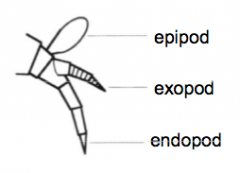
What evidence is consistent with the notion that wings are homologs of epipods and therefor are appendage derivatives/elaborations of this?
|
|
|
• Specializations for chewing, sponging, slicing, piercing and sucking has allowed for insect success
|
How have mouthparts diversified in the Class Insecta and why is this important?
|
|
|
• Chewing - found in grasshoppers and cockroaches
|
What is the ancestral type of insect mouthparts?
|
|
|
• Sponging - "lapping" of labium
|
What kind of mouthparts are found in houseflies?
|
|
|
• Cutting & spongin - slices epidermis then labium to sop up blood
|
What kind of mouthparts are found in horseflies?
|
|
|
• Piercing and sucking - labium supports stiletto as it pierces then surrounds when not feeding
|
What kind of mouthparts does a mosquito have?
|
|
|
• Sucking - maxillae held together with hooks to form proboscis
|
What kind of mouthpart does a butterfly have?
|
|
|
• External surfaces of photoreceptive convex facets each at a slightly different angle
• A "pixellated" image from each unit contributes one 'pixel' and brain puts together a composite • One unit is called a ommatidium |
Explain how a compound eye works.
|
|
|
• Ommatidium
• A - cornea • B -crystalline cone (lens) • C - retinular cell (8 in a circle) • D - rhabdom - made up of microvilli at the end of each retinular cell |
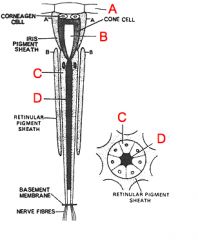
Name above parts of individual unit of an apposition compound eye. What is this single unit called?
|
|
|
• Superposition eyes are more derived and the apex of their crystalline cone is much farther away from the retinular cell
• Superposition eyes can be: • light adapted - light in each ommatidium is isolated to its own retinular cell • dark adapted - lighting coming in to ommatidium can be photomultiplied and they are receiving light from neighboring ommatidia |
What are the differences between an apposition and superposition compound eye?
|
|
|
• Morphological: crypsis or mimicry
• Behavioral: flight, projectile defecation so as not to give away location, petiole clipping (by leaf eaters), behavioral crypsis • Chemical: stings & venom, easy bleeding (ladybugs), bombardier beetles ass spray |
What are some defensive strategies used by Class Insecta?
|
|
|
• H202 in one storage reservoir adjacent to hydroquinones in another join in the middle in a reaction chamber with catalases - the reaction is highly exothermic and explosive hot toxic fluid is shot from anus
|
What is the bombardier beetles defensive strategy?
|
|
|
• Mayflies - external trachea used to take O2 out of water
• Dragonflies - internal rectal gills |
Insects who's life cycle involves aquatic larvae have modified gas exchange systems, give two examples of these.
|
|
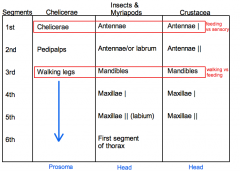
|
What are the differences in appendages between Subphyla appendages with Phyla Arthropoda?
|
|
|
• Thought crustacean mandibles from coxea only and insect mandibles from coxae and distal articles
• Suspected that D|| (transcription factor) would be found in insects but not in crustaceans • D|| was not found in either clade and therefore the hypothesis is not supported |
What is the Maton Homoplasy Hypothesis and why is it no longer valid?
|
|
|
• Ancestral crustaceans and insects were polyramic
• All but one rami lost in insects and all but two in crustaceans |
What ancestral evidence allows us to state that crustaceans and insects came from polyphyletic taxonomy?
|
|
|
• Millipedes: slow stroke with a fast recovery, most legs on ground at one time - slow moving but more power
• Centipedes: rapid stroke with slow recovery with only a few legs on the ground at one time - fast moving but less power |
How is locomotion different in centipedes and millipedes?
|
|
|
• Flattened foot
• Reduced cephalization • Spacious mantle cavity |
What are Bivalvia adaptations for life within sediments?
|
|
|
• Burrowers - deep or shallow
• Attached - with byssal threads or cemented directly with CaCO3 • Boring - eg shipworms |
What are the different lifestyles of Bivalvia?
|
|
|
• They feed by suspension and also eat wood particles
• Cellulases secreted by symbiotic bacteria in gut |
What do shipworms eat?
|
|
|
• Radial muscles of mantle contract drawing in water through olfactory groove
• Circular muscles of mantle contract to cause water to be forced out of funnel |
How does the funnel of Cephalopods bring in a exhale water?
|
|
|
• Ventilation of gills by pumping of muscular mantle
• Closed circulatory system with capillary beds • Systemic and branchial hearts - branchial hearts are booster pumps to force blood through gills • Travels from ctenidia to systemic heart to the body and capillary beds then to the branchial heart and back to ctenidia • Mollusks: O2 travels from ctenidia to heart to body and haemal sinuses then back to ctendia |
How does the gas exchange system of squid differ from that of other conventional mollusks?
|
|
|
• They are dioecious
• Hectocotylus of males (one tentacle) is specialized for spermatophore transfer • Lay large egg with lots of yolk and direct development takes place (no larvae) |
How do Cephalopods reproduce?
|
|
|
• They were thought to be acoelomates such as Platyhelminthes but they have mesothelium lined ecoelomic compartments: Rhynchocoel (proboscis sac) and lateral blood vessels
|
Why are Nemerteans now believed to be more closely related to Annelida and Mollusca than compared to Platyhelminthes?
|
|
|
• A - abdomen
• B - cephalothorax • C - ocelli - simple eye retained from nauplius larvae • D - 1st antennae - sensory • E - 2nd antennae - swimming • F - mandible • G - 1st maxillae • H - 2nd maxillae - food capture • I - maxillipeds - feeding • J - thoracopods - hop swim • K - caudal rami |
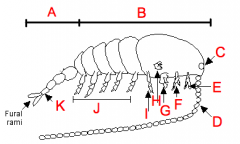
Identify parts A-K of above Copepoda.
|
|
|
• pull of gravity
• depth-dependent light • nowhere to hide • dilute resources (food, mates) • small Reynolds number |
What are environmental parameters withhold pelagic copepods?
|
|
|
• Reynolds number describes relative importance of viscous forces vs inertial forces in the flow of fluid past an object
= velocityXsizeXdensity(H20) / viscosity(H20) • Small Reynolds numbers are dominated by viscous forces • Large Reynolds numbers are dominated by inertial forces |
What are Reynolds numbers?
|
|
|
• Laminar flow
|
What kind of fluid flow is associated with a small Reynolds number?
|
|
|
• Turbulent flow
|
What kind of fluid flow is associated with a large Reynolds number?
|
|
|
• Swimming (2nd pair antennae)
• Parachute (1st pair antennae creates drag) • Lipid droplets (lower spec. gravity than H20 therefore buoyant) |
How do Copepods maintain their position in the water column?
|
|
|
• Being transparent
• Loss of compound eye which is associated with pigmentation • Hop swim • Myelin sheaths |
How do Copepods avoid/escape predators?
|
|
|
• Females release a pheromonal trail which male detect in gradients and can follow
|
How do Copepods detect mates?
|
|
|
• Acorn barnacles
• Stalked (gooseneck) barnacles • Parasitic barnacles |
What are different kinds animals found in Subclass Cirripedia?
|
|
|
• A - carina
• B - rostrum • C - lateral plate |

Name parts of Subclass Cirripedia exoskeleton.
|
|
|
• Hermaphroditic - probably do to sessile lifestyle
• Longest penis to body ratio which may be stretched into adjacent barnacle when open |
How does Subclass Cirripedia reproduce?
|
|
|
• Velocity and size
|
What two factors are most important in calculating Reynolds number?
|
|
|
• They are dioecious
• Morphology is completely derived • Only similarity is the nauplius larvae |
How do parasitic barnacles compare to other barnacles?
|
|
|
• Branchial cavity - area between the lateral flaps of terga (branchiostegum)
|
Where are the gills (epipods) of Subclass Malacostraca found?
|
|
|
• Head: 5 pairs
- antennae 1 & 2 - mandibles - maxillae 1 & 2 • Thorax: 8 pairs - thoracopods - maxillipeds - access mouthparts - pereopods - walking • Abdomen: 6 pairs - pleopods - 5 swimmerettes - uropods |
What are the appendages associated with each body part of Subclass Malacostraca?
|
|
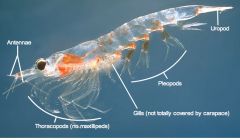
• Incomplete Branchiostegites (not much of a gill cavity)
• No maxillipeds • Thoracopods are form filtering baskets • Diel vertical migration • Swarming behavior • Photophores - lenses & reflectors light emission - social interactions - antipredator |
What are characteristics of Krill (Order Euphausiacea, Phylum Arthropoda, Subphylum Mandibulata, Class Crustacea, Subclass Malacostraca)?
|
|
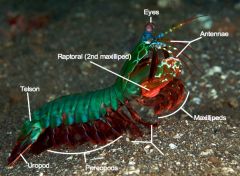
• 5 maxillipeds - 2nd pair are heavily calcified raptorial appendages for prey capture, defense & territorial disputes
- spearing maxillipeds are found in burrowing mantis shrimp - smashing maxillipeds are found in rock crevices • Rotatable eyes with a wide field of view, 16 visual pigments (humans have 3), and are sensitive to polarized light |
What are characteristics of mantis shrimp (Phylum Arthropoda, Subphylum Mandibulata, Class Crustacean, Subclass Stomatopods)?
|
|
|
• Only pelagic lifestyle
|
What are holopelagic species?
|
|
|
• Pelagic and benthic phases of lifestyle
|
What are pelago-benthic species?
|
|
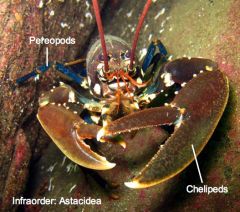
• Massive pereopods
• Muscular abdomen • Pleopods for swimming • Open gill chambers • Chelipeds (4th pair thoracopods) |
What are characteristics of crayfish & lobster (Phylum Arthropoda, Subphylum Mandibulata, Class Crustracea, Subclass Malacostraca, Order Decapoda, Infraorder Astacidea)?
|
|

• Loss of uropods & reduction of abdomen
• Maxillipeds epipods with setous endings used to clean gills • Reduction of pleopods - male have one pair for sperm transfer - female have 4/5 pair for holding onto egg mass • Closed gill chambers - able to borrow • Flat cephalothorax - heavily calcified • Robust pereopods for burrowing and walking • Chelipeds (4th pair thoracopods) |
What are characteristics of crab (Phylum Arthropoda, Subphylum Mandibulata, Class Crustracea, Subclass Malacostraca, Order Decapoda, Infraorder Brachyura)?
|
|
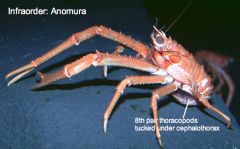
• 8th pair of thoracopods highly reduced - used to clean gills
• Abdomen tucked under cephalothorax • Hermit crabs have uropods with rasps for clinging to inside of shell and have an asymmetric coil of abdomen to hold onto columnella of gastropod shell |
What are characteristics of squat lobster, hermit crab & porcelain crab (Phylum Arthropoda, Subphylum Mandibulata, Class Crustracea, Subclass Malacostraca, Order Decapoda, Infraorder Anomura)?
|
|
|
• Mesoderm
|
Where are ossicles found in Echinodermata sercreted?
|
|
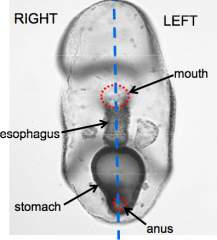
• At the larval stage they have bilateral symmetry
|
Echinodermata have pentamerous radial symmetry except when?
|
|
|
• Store water and maintain pressure
|
What are polian vesicles used for in the water vascular system?
|
|
|
• Basically, the space inside the body but outside the various organs
|
Where is the perivisceral coelom found in various animals?
|
|
|
• A - pedicellariae
• B - papula • C - spines • D - ossicle • E - gonads • F - perihemal sinus • G - radial hemal vessel • H - tube foot • I - ampulla • J - pyloric caeca • K - perivisceral cavity |
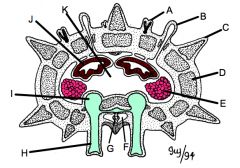
Label parts of A-K of above Asteroidea leg cross-section.
|
|
|
• Dioecious
• Broadcast spawn • Planktonic, feeding larva • Catastrophic metamorphosis - adult forming within larva and bursting out |
How do Asteroidea reproduce?
|
|
|
• Chucking guts - such as Holothuroidea
|
What is evisceration?
|
|
|
• A - muscle
• B - perivisceral coelom • C - aboral arm shield • D - lateral arm shield • E - spines • F - ossicle • G - radial canal • H - oral shield • I - podia (no ampulla/suckers) |
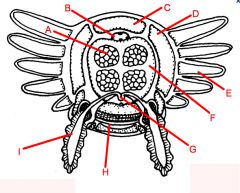
Identify parts A-H of above Ophuroidea arm cross section.
|
|
|
• Through bursal slits
|
How do Ophiuroidea exchange gas?
|
|
|
• Tunic - tunicin is cellulose-like fibrous material secreted by epidermic
• No metamerism • Coelom confined to pericaridum (major secondary body cavity is hemocoel) |
What are characteristics of Subphylum Urochordata (=Tunicata)?
|
|
|
• A - buccal siphon (water in)
• B - atrial siphon (water out) • C - tunic • D - endostyle (secretes an iodine containing mucous that gets carried along by frontal cilia and rolled into a rope at dorsal lamina and carried to esophagus) • E - anus • F - stigmata • G - atrium • H - stomach • I - esophagus |
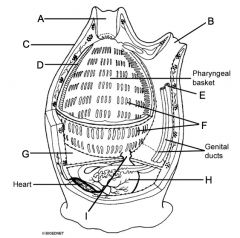
Label parts A-I of above Ascidiacae.
|
|
|
• Class Ascidiacea
• Class Larvacea • Class Thaliacea |
What Classes exist within Subphylum Urochordata?
|
|
|
• Ecteinascidia turbinata - 'Yondelis'
|
What is a believed source of anti-cancer drug?
|

